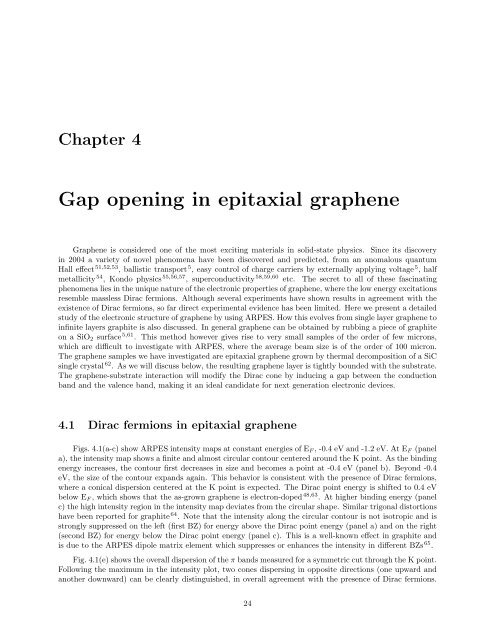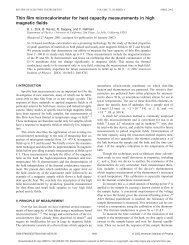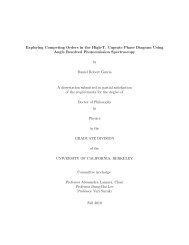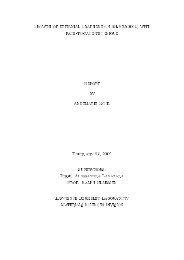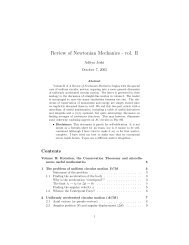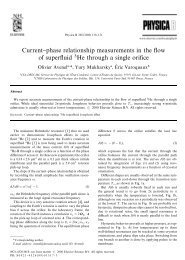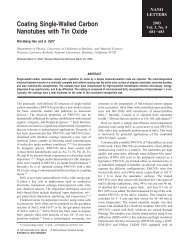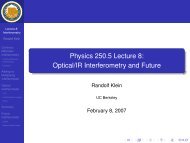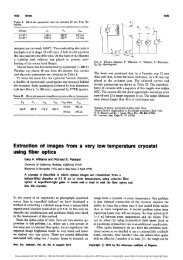Dirac Fermions in Graphene and Graphiteâa view from angle ...
Dirac Fermions in Graphene and Graphiteâa view from angle ...
Dirac Fermions in Graphene and Graphiteâa view from angle ...
You also want an ePaper? Increase the reach of your titles
YUMPU automatically turns print PDFs into web optimized ePapers that Google loves.
Chapter 4<br />
Gap open<strong>in</strong>g <strong>in</strong> epitaxial graphene<br />
<strong>Graphene</strong> is considered one of the most excit<strong>in</strong>g materials <strong>in</strong> solid-state physics. S<strong>in</strong>ce its discovery<br />
<strong>in</strong> 2004 a variety of novel phenomena have been discovered <strong>and</strong> predicted, <strong>from</strong> an anomalous quantum<br />
Hall effect 51,52,53 , ballistic transport 5 , easy control of charge carriers by externally apply<strong>in</strong>g voltage 5 , half<br />
metallicity 54 , Kondo physics 55,56,57 , superconductivity 58,59,60 etc. The secret to all of these fasc<strong>in</strong>at<strong>in</strong>g<br />
phenomena lies <strong>in</strong> the unique nature of the electronic properties of graphene, where the low energy excitations<br />
resemble massless <strong>Dirac</strong> fermions. Although several experiments have shown results <strong>in</strong> agreement with the<br />
existence of <strong>Dirac</strong> fermions, so far direct experimental evidence has been limited. Here we present a detailed<br />
study of the electronic structure of graphene by us<strong>in</strong>g ARPES. How this evolves <strong>from</strong> s<strong>in</strong>gle layer graphene to<br />
<strong>in</strong>f<strong>in</strong>ite layers graphite is also discussed. In general graphene can be obta<strong>in</strong>ed by rubb<strong>in</strong>g a piece of graphite<br />
on a SiO 2 surface 5,61 . This method however gives rise to very small samples of the order of few microns,<br />
which are difficult to <strong>in</strong>vestigate with ARPES, where the average beam size is of the order of 100 micron.<br />
The graphene samples we have <strong>in</strong>vestigated are epitaxial graphene grown by thermal decomposition of a SiC<br />
s<strong>in</strong>gle crystal 62 . As we will discuss below, the result<strong>in</strong>g graphene layer is tightly bounded with the substrate.<br />
The graphene-substrate <strong>in</strong>teraction will modify the <strong>Dirac</strong> cone by <strong>in</strong>duc<strong>in</strong>g a gap between the conduction<br />
b<strong>and</strong> <strong>and</strong> the valence b<strong>and</strong>, mak<strong>in</strong>g it an ideal c<strong>and</strong>idate for next generation electronic devices.<br />
4.1 <strong>Dirac</strong> fermions <strong>in</strong> epitaxial graphene<br />
Figs. 4.1(a-c) show ARPES <strong>in</strong>tensity maps at constant energies of E F , -0.4 eV <strong>and</strong> -1.2 eV. At E F (panel<br />
a), the <strong>in</strong>tensity map shows a f<strong>in</strong>ite <strong>and</strong> almost circular contour centered around the K po<strong>in</strong>t. As the b<strong>in</strong>d<strong>in</strong>g<br />
energy <strong>in</strong>creases, the contour first decreases <strong>in</strong> size <strong>and</strong> becomes a po<strong>in</strong>t at -0.4 eV (panel b). Beyond -0.4<br />
eV, the size of the contour exp<strong>and</strong>s aga<strong>in</strong>. This behavior is consistent with the presence of <strong>Dirac</strong> fermions,<br />
where a conical dispersion centered at the K po<strong>in</strong>t is expected. The <strong>Dirac</strong> po<strong>in</strong>t energy is shifted to 0.4 eV<br />
below E F , which shows that the as-grown graphene is electron-doped 48,63 . At higher b<strong>in</strong>d<strong>in</strong>g energy (panel<br />
c) the high <strong>in</strong>tensity region <strong>in</strong> the <strong>in</strong>tensity map deviates <strong>from</strong> the circular shape. Similar trigonal distortions<br />
have been reported for graphite 64 . Note that the <strong>in</strong>tensity along the circular contour is not isotropic <strong>and</strong> is<br />
strongly suppressed on the left (first BZ) for energy above the <strong>Dirac</strong> po<strong>in</strong>t energy (panel a) <strong>and</strong> on the right<br />
(second BZ) for energy below the <strong>Dirac</strong> po<strong>in</strong>t energy (panel c). This is a well-known effect <strong>in</strong> graphite <strong>and</strong><br />
is due to the ARPES dipole matrix element which suppresses or enhances the <strong>in</strong>tensity <strong>in</strong> different BZs 65 .<br />
Fig. 4.1(e) shows the overall dispersion of the π b<strong>and</strong>s measured for a symmetric cut through the K po<strong>in</strong>t.<br />
Follow<strong>in</strong>g the maximum <strong>in</strong> the <strong>in</strong>tensity plot, two cones dispers<strong>in</strong>g <strong>in</strong> opposite directions (one upward <strong>and</strong><br />
another downward) can be clearly dist<strong>in</strong>guished, <strong>in</strong> overall agreement with the presence of <strong>Dirac</strong> fermions.<br />
24


